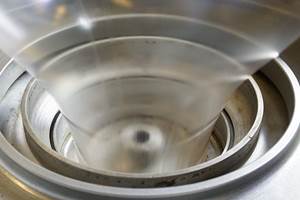Working with Color Concentrates
Because the consumer sees so many colored plastic articles, it is natural to assume that the process of achieving molded-in color is a simple one. Those of us in the industry know differently.
One of the big advantages that plastics have over metals is the option of providing molded-in color. While many large parts are still painted in order to achieve the desired aesthetics, even in these cases the eventual goal is the elimination of the paint line in favor of color that is incorporated directly into the base polymer.
Because the consumer sees so many colored plastic articles, it is natural to assume that the process of achieving molded-in color is a simple one. Those of us in the industry know differently. Selecting a colorant system must take into account chemical compatibility with the base resin, the ability to achieve a suitable color match with a standard, surviving the stresses and temperatures of the fabrication process, and providing durability in the colorant system to match the life of the product while at the same time meeting cost constraints. It is not as easy as it looks.
Once the appropriate colorant system has been developed for an application, a choice must be made between molding the part from a fully compounded material where the color has been incorporated uniformly into the raw material, or using a color concentrate that is added to the base resin at the machine just before molding the part. The concentrate can be in the form of a pellet, powder, or liquid. In all cases the principle is the same: Add a relatively small amount of concentrated color to a much larger amount of natural-colored polymer and produce a finished part of the correct color by using the temperatures and mechanical work of the process to distribute the color uniformly.
There are potentially significant economic incentives to the color concentrate approach. First, most resin suppliers today prefer not to tie up their capacity producing small lots of custom-colored product. It was not always the case. In the mid-1980s I visited what was then a Borg-Warner plant making various grades of ABS. Not only did Borg-Warner offer a wide variety of ABS resins with different properties, they took great pride in providing a wide range of fully compounded colors.
During the tour we saw many lines running everything from white to burgundy, and we were taken to the color lab where more than 40,000 different color formulations had been created over the years. Over 6000 of these, we were told, were commercially active. Color matching and compounding were a core competency, to use the buzzword vernacular of today, and it represented a skill set that was marketed as a competitive advantage.
Today, providing small lots of a wide variety of colors is not something that the “majors” want to spend their resources on unless the volumes are significant. Even in these cases there is no guarantee that the color compounding is being done at a facility owned and operated by the company whose name is on the bag or gaylord of material. The coloring operation is often outsourced to a compounding firm that makes its living producing these smaller lots.
The cost for converting natural-colored material to a specialty color can be high; as much as three to five times that of the base-resin cost if volumes are low. While the cost per pound for color concentrates can be very high, these materials are typically only added at letdown ratios of 2 to 5 lb per 100 lb of natural resin. So even a very expensive color concentrate typically allows the processor to achieve an aggregate cost for the colored product that is substantially less than that of the fully compounded material.
Then there is the matter of inventory. Managing multiple colors for a product line can be challenging, especially since consumption of different colors follows changes in the public’s tastes. One of the first jobs that I had in the industry involved going through the raw material section of the warehouse and disposing of the obsolete precolored materials that had been purchased at one time for production needs and then had languished in storage as demand sank. Thousands of pounds of avocado green, harvest gold, burnt orange, and something called desert sand were consigned to the dumpster at a cost of tens of thousands of dollars. If these colors had been achieved using color concentrates, the economic damage would have been limited to much smaller containers of concentrate and the natural resin could have remained natural for molding the newer colors that were in demand.
Lead times are also part of this picture. Once the matching process has been completed, most color concentrate orders can be delivered in two to three weeks. The lead time for fully compounded materials is typically much longer. I can recall one application for a relatively large part that we ran in an impact-modified, glass-reinforced nylon 6 in red, green, and yellow. Initially, the material was supplied in fully compounded form. But the supplier was constantly late with shipments. The red and the yellow would be delivered but the green would not show up for another two weeks. So we would put the mold in the press and produce part of our customer’s order and then have to hang the mold again two or three weeks later to finish the order.
All this costs money. Finally we ordered only natural resin from our material supplier and obtained color concentrates from our colorant supplier. And let’s not forget about that minimum order quantity. Today even the smaller producers want to make at least 1000 to 1500 lb of something once they have the extruder running. There are many applications where even this relatively small amount of material lasts for years.
Finally, there is the matter of thermal history. Many people have a phobia about reground materials. There are a lot of part drawings out there with notes that restrict or forbid the use of regrind in the manufacturing process because of a perception that once the material has been through the molding process it is somehow damaged goods and is only fit to be sold as scrap. The color compounding process subjects the original material to an additional heat history before it ever reaches the processor. Most of this compounding is accomplished without a significant loss in performance.
However, property changes are a potential result any time a material is melted and subjected to mechanical work such as occurs during the compounding process. Using natural plus color concentrate eliminates this intermediate step and has the ability to deliver a potentially superior final product.
So why is there still so much fully compounded material out there? There are practical challenges to bringing the coloring process into the molding plant. These include ratio control, proper color incorporation, consistency in the color of the base resin, and purchasing color concentrates that do not contain hidden problems caused by incorrect material and molecular-weight selection. We will discuss each of these in detail in upcoming columns.
Related Content
Multilayer Solutions to Challenges in Blow Molding with PCR
For extrusion blow molders, challenges of price and availability of postconsumer recycled resins can be addressed with a variety of multilayer technologies, which also offer solutions to issues with color, processability, mechanical properties and chemical migration in PCR materials.
Read MoreUpdated Controller for Sealed Gravimetric Liquid Color and Additives System
NPE2024: Riverdale Global’s new RGS controller features and intuitive set-up procedure.
Read MoreReduce Downtime and Scrap in the Blown Film Industry
The blown film sector now benefits from a tailored solution developed by Chem-Trend to preserve integrity of the bubble.
Read MoreThe Steps to Consistent Color in Plastics
Unlock the secrets to flawless color duplication in your production processes. Discover why expert color replication is paramount for maintaining quality, reducing costs, and ensuring client satisfaction and retention. Download now to gain insights that will revolutionize your approach to color control.
Read MoreRead Next
Beyond Prototypes: 8 Ways the Plastics Industry Is Using 3D Printing
Plastics processors are finding applications for 3D printing around the plant and across the supply chain. Here are 8 examples to look for at NPE2024.
Read MoreFor PLASTICS' CEO Seaholm, NPE to Shine Light on Sustainability Successes
With advocacy, communication and sustainability as three main pillars, Seaholm leads a trade association to NPE that ‘is more active today than we have ever been.’
Read MoreSee Recyclers Close the Loop on Trade Show Production Scrap at NPE2024
A collaboration between show organizer PLASTICS, recycler CPR and size reduction experts WEIMA and Conair recovered and recycled all production scrap at NPE2024.
Read More
.jpg;width=70;height=70;mode=crop)





















